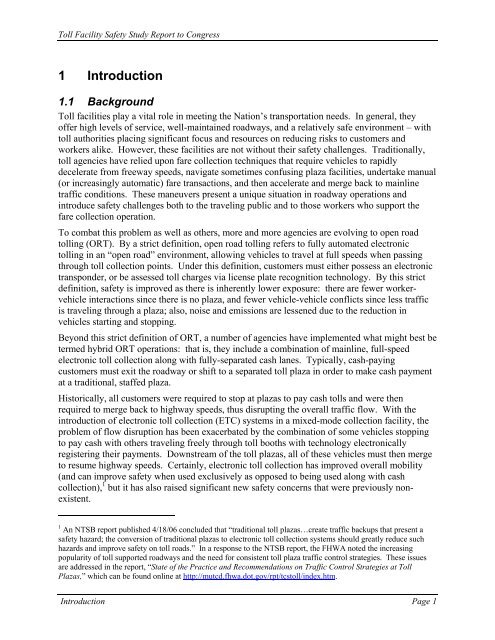Toll Facility Safety Study Report to Congress - About
Toll Facility Safety Study Report to Congress - About
Toll Facility Safety Study Report to Congress - About
You also want an ePaper? Increase the reach of your titles
YUMPU automatically turns print PDFs into web optimized ePapers that Google loves.
<strong>Toll</strong> <strong>Facility</strong> <strong>Safety</strong> <strong>Study</strong> <strong>Report</strong> <strong>to</strong> <strong>Congress</strong><br />
1 Introduction<br />
1.1 Background<br />
<strong>Toll</strong> facilities play a vital role in meeting the Nation’s transportation needs. In general, they<br />
offer high levels of service, well-maintained roadways, and a relatively safe environment – with<br />
<strong>to</strong>ll authorities placing significant focus and resources on reducing risks <strong>to</strong> cus<strong>to</strong>mers and<br />
workers alike. However, these facilities are not without their safety challenges. Traditionally,<br />
<strong>to</strong>ll agencies have relied upon fare collection techniques that require vehicles <strong>to</strong> rapidly<br />
decelerate from freeway speeds, navigate sometimes confusing plaza facilities, undertake manual<br />
(or increasingly au<strong>to</strong>matic) fare transactions, and then accelerate and merge back <strong>to</strong> mainline<br />
traffic conditions. These maneuvers present a unique situation in roadway operations and<br />
introduce safety challenges both <strong>to</strong> the traveling public and <strong>to</strong> those workers who support the<br />
fare collection operation.<br />
To combat this problem as well as others, more and more agencies are evolving <strong>to</strong> open road<br />
<strong>to</strong>lling (ORT). By a strict definition, open road <strong>to</strong>lling refers <strong>to</strong> fully au<strong>to</strong>mated electronic<br />
<strong>to</strong>lling in an “open road” environment, allowing vehicles <strong>to</strong> travel at full speeds when passing<br />
through <strong>to</strong>ll collection points. Under this definition, cus<strong>to</strong>mers must either possess an electronic<br />
transponder, or be assessed <strong>to</strong>ll charges via license plate recognition technology. By this strict<br />
definition, safety is improved as there is inherently lower exposure: there are fewer workervehicle<br />
interactions since there is no plaza, and fewer vehicle-vehicle conflicts since less traffic<br />
is traveling through a plaza; also, noise and emissions are lessened due <strong>to</strong> the reduction in<br />
vehicles starting and s<strong>to</strong>pping.<br />
Beyond this strict definition of ORT, a number of agencies have implemented what might best be<br />
termed hybrid ORT operations: that is, they include a combination of mainline, full-speed<br />
electronic <strong>to</strong>ll collection along with fully-separated cash lanes. Typically, cash-paying<br />
cus<strong>to</strong>mers must exit the roadway or shift <strong>to</strong> a separated <strong>to</strong>ll plaza in order <strong>to</strong> make cash payment<br />
at a traditional, staffed plaza.<br />
His<strong>to</strong>rically, all cus<strong>to</strong>mers were required <strong>to</strong> s<strong>to</strong>p at plazas <strong>to</strong> pay cash <strong>to</strong>lls and were then<br />
required <strong>to</strong> merge back <strong>to</strong> highway speeds, thus disrupting the overall traffic flow. With the<br />
introduction of electronic <strong>to</strong>ll collection (ETC) systems in a mixed-mode collection facility, the<br />
problem of flow disruption has been exacerbated by the combination of some vehicles s<strong>to</strong>pping<br />
<strong>to</strong> pay cash with others traveling freely through <strong>to</strong>ll booths with technology electronically<br />
registering their payments. Downstream of the <strong>to</strong>ll plazas, all of these vehicles must then merge<br />
<strong>to</strong> resume highway speeds. Certainly, electronic <strong>to</strong>ll collection has improved overall mobility<br />
(and can improve safety when used exclusively as opposed <strong>to</strong> being used along with cash<br />
collection), 1 but it has also raised significant new safety concerns that were previously nonexistent.<br />
1 An NTSB report published 4/18/06 concluded that “traditional <strong>to</strong>ll plazas…create traffic backups that present a<br />
safety hazard; the conversion of traditional plazas <strong>to</strong> electronic <strong>to</strong>ll collection systems should greatly reduce such<br />
hazards and improve safety on <strong>to</strong>ll roads.” In a response <strong>to</strong> the NTSB report, the FHWA noted the increasing<br />
popularity of <strong>to</strong>ll supported roadways and the need for consistent <strong>to</strong>ll plaza traffic control strategies. These issues<br />
are addressed in the report, “State of the Practice and Recommendations on Traffic Control Strategies at <strong>Toll</strong><br />
Plazas,” which can be found online at http://mutcd.fhwa.dot.gov/rpt/tcs<strong>to</strong>ll/index.htm.<br />
Introduction Page 1

















